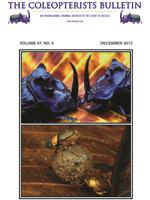A guild of Neotropical rainforest dung- and carrion-feeding beetles (Scarabaeinae, Aphodiinae, Trogidae) at Reserva Florestal Ducke in Amazonian Brazil was inventoried using baited pitfall traps continuously for 56 weeks during September 1977 to October 1978. The 20 traps were baited with either dung or carrion, and the preservatives in the traps were solutions of either chloral hydrate or picric acid so that all combinations of bait and preservatives were present. A total of 19,416 specimens, 66 species, 20 genera, two subfamilies of Scarabaeidae (Scarabaeinae and Aphodiinae), and two families (Scarabaeidae and Trogidae) were collected during the 56-week study. The by-catch of approximately 300,000 other insects was retained at the Instituto Nacional de Pesquisas da Amazônia (INPA) for further studies. In the dung traps, 14,413 specimens were collected (74% of all scarabaeoids collected). In the carrion traps, 5,003 specimens were collected (26% of all scarabaeoids collected). The mean number of individuals collected per week in all traps was 345.7 ± 14.6 (SEM) with a range of 144 specimens on 11 October 1978 to 649 specimens on 19 September 1978. The mean number of species taken per week for all traps was 33.0 ± 0.9 (SEM) with a peak catch of 47 species in week 19 (17 January) and a minimum of 18 species in week 51 (29 August). All 66 species were taken in the dung traps, but only 34 species were taken in the carrion traps. Differences between the number of individuals and species captured in the chloral hydrate and picric acid solutions were negligible and demonstrate no real advantage of either one except for easier availability and safety of the chloral hydrate solution. Regression analyses indicated no correlation of precipitation with numbers of individuals or numbers of species taken weekly in the traps. If the “rare” species (singletons and “tourists” comprising less than 0.005% of the total catch in each bait group) are eliminated from the analysis, then the dung traps took 10 weeks to acquire the 17 “common” species (48 species eliminated), and the carrion traps took 12 weeks to capture the 11 “common” species (23 species eliminated). This illustrates the necessity for long-term trapping to accurately identify the species diversity in a study area. In the dung traps, the 17 common species accounted for 95% of the total numbers collected. In the carrion traps, the 11 common species accounted for 96% of the total numbers collected. The last new species to enter a dung trap was in week 48, and the last new species to enter a carrion trap was in week 53. The data show that “trapping out” in this primary rainforest site did not occur since weekly captures remained robust.
How to translate text using browser tools
1 December 2013
The Dung- and Carrion-Feeding Scarabs (Coleoptera: Scarabaeoidea) of an Amazonian Blackwater Rainforest: Results of a Continuous, 56-Week, Baited-PitfallTrap Study
Brett C. Ratcliffe
ACCESS THE FULL ARTICLE

The Coleopterists Bulletin
Vol. 67 • No. 4
December 2013
Vol. 67 • No. 4
December 2013
biodiversity sampling
ecology
Neotropics
Scarabaeidae
Trogidae
tropical rainforest




